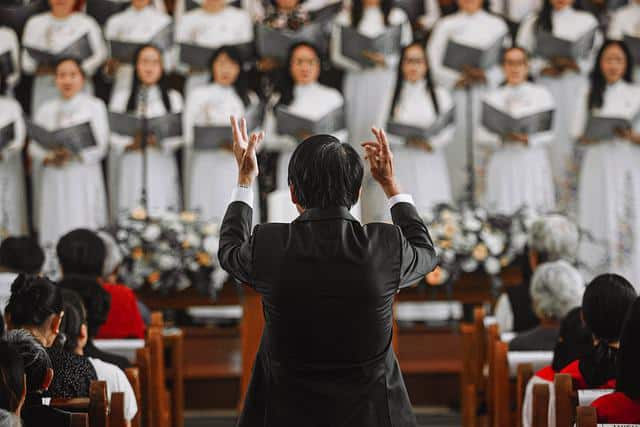
The members of each string of a choir usually sing in unison.
Originating from the Latin word unisŏnus , the term unison refers to that which has the same sound or tone as another element . The concept can also be used to name the musical fragment with instruments or voices that sound in equal tones .
musical interval
When two tones have the same pitch , although they are perceived as coming from different sources, they are unison tones. It can be said that unison is a type of musical interval .
Two instruments playing the same note at the same time are sounding in unison. In this way, two notes are generated that, although they are the same, can have different timbres , making it possible to differentiate them.
Suppose that with an acoustic guitar and a keyboard you play a certain melody . Both instruments sound simultaneously and in unison, but you can recognize and distinguish the guitar notes on one side and the keyboard notes on the other. In popular music, the well-known Argentine singer Estela Raval stood out for her interpretation of the song titled Balada de la Trumpeta , in which she must sing a melody in unison with the performer of said instrument.
On the other hand, although there are pieces with these characteristics, in a choir , it is common for each group of strings to play different notes. However, in each of them its members do sing in unison. To be more specific, we can say that all the light tenors sing the same notes simultaneously, and they complement each other with the melodies of the basses, sopranos and contraltos.
in unison
As an adverbial phrase, meanwhile, the expression "in unison" refers to what is expressed or carried out unanimously, without any divergences or disagreements . For example : "When the mayor left the premises, hundreds of people who were in the street booed him in unison and asked for his resignation" , "We are going to work in unison to solve this problem as soon as possible" , "Thousands of young people cheered the legendary artist in unison and showed their admiration .
In these three sentences we notice different nuances that are very interesting to understand the scope of the term in question, which in many cases goes beyond the musical field and even phonation or sound emission. Let's start with the first, in which the broadcaster states that hundreds of people waited on public roads until the mayor came out to boo him and demand his resignation. According to the story, the voices of all the protesters seemed coordinated, since their shouts of protest sounded at the same time and, therefore, it was possible to understand their words.

In a public demonstration, protests can sound in unison.
In the case of the second sentence, we are dealing with a particular use of unison , which does not refer to sounds or music at all. When the speaker talks about "working in unison" he means that they do so in an organized and synchronized manner, that they combine their energies in an orderly manner to focus them on solving the problem as soon as possible. In other words, its intention is for everyone to do their part to enhance the results, since we know that by joining forces we become more powerful.
Finally we come to another example in which the term does refer to the use of the voice to make sounds. However, in this case it is not about music nor is it about a protest; On the contrary, it is a manifestation of admiration towards an artist on the part of his admirers. It is not unusual for fans in these contexts to agree to improvise certain chants or phrases that they repeat in unison so that their idol can receive them.
